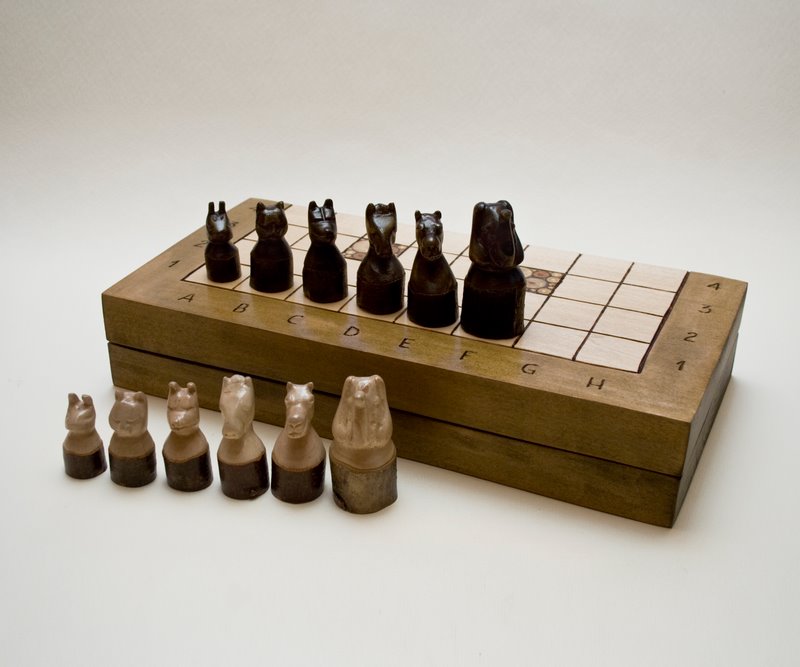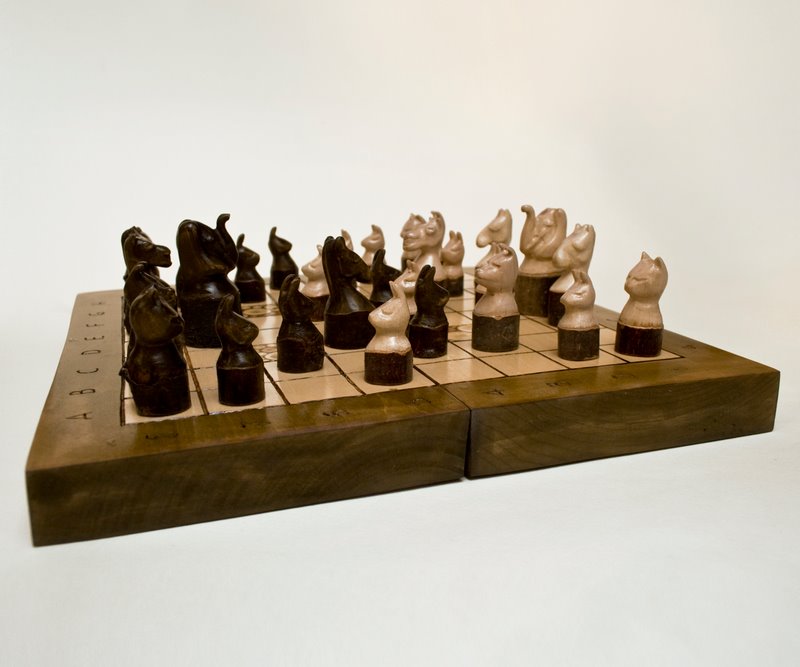Arimaa

6 years ago when I started university in Bucharest, after attending some class on formal languages I got to know a friend that later introduced me to Arimaa, a very new strategy game (compared to chess or Go).
I still feel thankful for meeting this person and getting to know a new game that not only made many stressful nights fun, kept my brain busy with mentally challenging tasks, but later on, when I left my country, helped me to connect with my new friends. I remember the instant reciprocated joy I felt when I met someone that was already an Arimaa player.
I don’t know how much you care about the fight between humans and machines, but Arimaa was designed in such a way that it won’t be as easy (as using a classic search algorithm) for a bot to win against a top player (as it happened in 1997 with Deep Blue against Garry Kasparov). Omar Syed put a reward for the first program which would be stronger than the human players. The challange stayed on for approximately 12 years since 2003, and in 2015 David Wu won the prize.
Basics
You have a common yard with your enemy that looks like an 8x8 grid.

The two players are: Gold and Silver. They have in their yard sixteen animals each (Gold’s animals are denoted by upper case letters and Silver’s animals by lower case letters): one elephant (E or e), one camel (M or m), two horses (H or h), two dogs (D or d), two cats (C or c), and eight rabbits (R or r) in descending order of friendliness strength. The relative friendliness strength of each piece lies in its power to push, pull, or immobilize weaker enemy pieces. Four squares of the game-board are traps, on which a piece can potentially be lost (c3, f3, c6, and f6). The yard is oriented with Gold on the southern side and Silver on the northern.
The animals can move in all cardinal directions and the moves are denoted by the animal, its original position, and the direction of moving (n for north, w for west, e for east, s for south).
A game of Arimaa will start with an empty yard. The names (Gold or Silver) of the players will be randomly chosen. Gold sets his animals on the first two rows closest to him. One thing I like in the setting up part is that now Gold can arrange his animals as he wishes. There is no fixed starting so the animals can take any square from the set up space. Once the Gold is done with placing his animals Silver sets his animals on his two closest rows. Again, Silver can also place his animals freely.
Each player will try to win by moving one of its rabbits to the enemy’s home row. A player can move animals up to 4 steps in one turn. An animal can’t move if it’s adjacent to a stronger animal of the enemy’s unless any friendly animal is also adjacent to it. Move pieces up to 4 steps in one turn. A piece can’t move if it’s adjacent to a stronger piece of opponent’s unless any friendly piece is adjacent to it.
Then each player will push and pull enemy’s weaker animals with a stronger animal of theirs. However, for a push or a pull two steps are required.
A piece in a trap, is removed from the game if it has no friendly adjacent piece.
Various tips and wishes that I got when I started:
-
You are allowed to place your animals on your yard as you wish, only with the elephant you can have some issues.
-
Take care to not leave your cat to fall in one of the traps. Same for the horses and the dogs. They are good animals to have in your yard.
-
May your camel be friendly and your elephant aggresive.
-
If you play with evil bots on the ladder bot thingy, take a little more care. Especially if its name is Ziltoid. Or sharp. Or marwin. Or …
-
If you are gold or you are silver, doesn’t really matter. Look up the stats, they won’t tell you much yet.
-
Be aggressive with the elephant, but always watch your traps and assure them. Because if you don’t you may lose a cat or a rabbit (like Fritzlein does). Fritzlein always sets rabbits of C2 and F2 and he is evil too, not as much as browni314, aka brown π (some of the early grandmasters).
-
Keep your horses always on flanks, if you play symmetric.
-
As you saw the vast majority of your pieces are moving as rooks in chess, with the exception of rabbits, they don’t go back, because they always rush to get to the goal, to the enemy end of yard.
-
Eliminate as much as you can, but not your own animals. If you will do this you might end up winning through elimination.
-
Take care to not let your enemy to imobilize you too often, this if you wish to have a chance to win at Arimaa.
-
The chances of getting your rabbit to the goal increase when the amount of animals of your enemy decreases. Oh, well… obvious, just saying.
-
Do not let your camel be kidnapped. Sign of bad luck. :)
-
When your rabbits are getting close the goal and are surrounded by friends is good, still watch over that evil enemy.
-
I don’t plan to get to deep in the explanation of “camel frame”, “horse frame”, “dog frame”, “cat frame”, but… those are harsh situations. Like in life, you are on the edge then, where the details and the configuration matters.
-
Keep your friend pieces always close. Even when a friend is cat, or a rabbit.
-
Don’t panic at any point in the game. You just need to order a bit your thoughts as you order your pieces in the beginning.
-
There are 4 traps. As romanians say, keep your eyes in 4. Well, I advise you to keep your eyes at least in 2.
Links
- Beginner tutorial
- Official gameroom
- Beginning Arimaa by Fritz Juhnke
- Online Arimaa Wikibook
- Arimaa Strategies and Tactics by Jean Daligault
If you want a fancy Arimaa table handcrafted in Romania, art3lier made several beautiful wooden ones for me and my friend that introduced me to the game.

